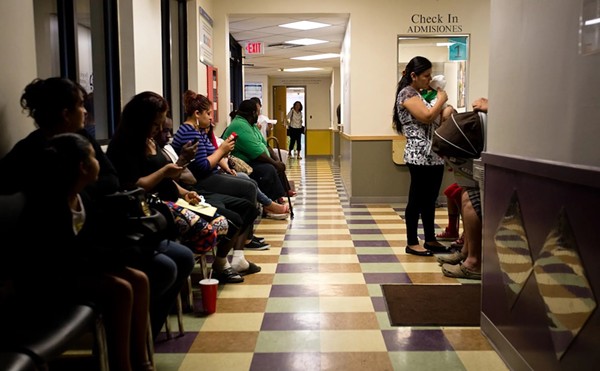In their last legislative session, Texas lawmakers cut $4 billion from the education budget to balance state coffers, sending school districts scrambling to make up for financial shortfalls. In an ideal world, you’d expect the Bexar Appraisal District, prompted by this unprecedented development, to scrutinize local tax rolls to ensure property owners — particularly commercial ones — are paying their full share of taxes benefiting schoolchildren. Instead the Bexar County Appraisal District has been granting San Antonio’s exclusive country clubs remarkable tax breaks on their real estate improvement values to the detriment of taxing entities in their midst, including cash-strapped schools. It seems the greater level of prestige and exclusivity, the sweeter the tax break.
Country clubs, for some reason, are appraised at a much smaller rate than typical residential and most commercial property. The hyper-exclusive Argyle at 934 Patterson Ave. in affluent Alamo Heights — a 30,000-square-foot mansion converted into a social club — is assessed at a mere $242,000 on county tax rolls — roughly a tenth of most homeowner property assessments in the neighborhood. And when considering real estate improvements only, the Current found the city’s four most exclusive country clubs — San Antonio Country Club, The Argyle, The Sonterra, and Dominion — collectively paid only $65,184 for taxable real estate improvements this year. Had they been appraised at rates comparable to the homes around them, these social institutions would have paid a collective $582,329.
“I think there’s a big flaw in the process, but these people are all well-connected and have those avenues,” said Northside ISD spokesman Pascual Gonzalez upon learning of the tax breaks, adding that “all of us have the responsibility to educate our schoolchildren.”
Like all school districts, Northside Independent School District is clinging to every dollar it can secure. As a result of the Legislature’s cuts this year, the district was forced to trim $61.5 million from its budget and eliminate nearly 1,000 positions. It’s much the same story at Northeast Independent School District, where $70 million in cuts over the next two years had to be made. Spokeswoman Chrissie Kolb noted the district has precious few commercial taxpayers contributing revenue through property taxes and numerous tax-exempt churches of various denominations, further heightening her concern of lowered tax bills for country clubs.
“If we have taxing entities that are at a lesser rate than our homeowners, that’s something that’s very disappointing,” Kolb said. “The commercial property owners we do have I would hope would be taxed the same way as all the others are.”
Among the country clubs, the most glaring example of discounted property tax rates is the ritzy San Antonio Country Club at 4100 N. New Braunfels Ave., which pays an astonishingly low $6.99 per square foot on its real estate improvements — exponentially less than the average $72.98 per square foot that surrounding homeowners pay. Even a humble mobile home in the 12000 block of Cinco de Mayo — a 1,200-square-foot model built in 1997 — is taxed at a rate almost four times higher, at $23.36 per square foot.
The difference between what the top four clubs with the biggest breaks should have paid this year versus what they did pay is $517,145 — half of which would’ve gone to school districts.
The Argyle in Alamo Heights paid a mere $8.32 per square foot in taxes for its taxable improvements — considerably less than the $144.07 paid by homeowners living in its shadows. The Sonterra Country Club was assessed at $23.30 per square foot compared to neighborhood averages of about $100; the Dominion was assessed at $11.77 per square foot versus the $97.63 of neighboring property owners.
“You’re not talking the same animal,” protested John Marotta, general manager at the Argyle. “A residence is a residence and we’re a business. It’s apples and oranges.”
Marotta — the only club manager to respond to an interview request — said the Argyle is a job creator, employing 50 workers that include restaurant and kitchen staff, a gardener, and a maid for four rooms that are rented out as hotel space. Additionally, the club pays taxes on alcohol sales, and other taxes on its other land parcels, Marotta noted. “You’re bringing this up and making it look like it’s a bad thing. It’s a good thing for Alamo Heights, the county, and the state. I might also add that we get five tax bills – a parcel there, a parcel here. We pay 14 cents for every dollar sold on liquor, beer and wine sales. We employ 50 people, and I would say mostly minorities. We employ 90 percent minorities.”
If the SilverHornGolf Club at 1100 W. Bitters Rd., a less-exclusive club advertising specials on tee times and beer, made that jobs-creator argument when it appealed for lower rates at the Bexar County Appraisal District, it didn’t work. (Neither did the enclosed financial statements or copy of a news article warning, “Golf clubs suffer in recession as membership dwindles,” secured by the Current under a public information request.) In fact, the Silverhorn was the one club reviewed that was held to surrounding property values of nearly $85 per square foot. The Current’s methodology for this story only includes living areas in the calculation mix, excluding outside elements such as tennis courts, swimming pools, decks, and patios, to achieve comparison uniformity.
Appraisal districts officials painted a picture of their work as somewhat esoteric and subjective — made more difficult by state requirements that fail to compel full financial disclosures from country club operators, resulting in the need for accounting alchemy.
“Country clubs are very unique and hard to value,” said Richard Hammond, the appraisal district’s commercial manager. “There’s no sales disclosure, and school districts are getting the short end of the stick. No one is going to give us that information when properties change hands, and that makes our jobs more difficult. Without sales data, it’s very hard.” Without knowing precisely how much these types of properties sell for,
the taxation process is largely based on property owners’ own assertions of their properties’ values, he said.
Commercial property owners are not required to submit financial data in Texas — income and expense statements, for example — that would help appraisers estimate true market value. What’s more, Texas lacks a database of commercial property sales analogous to the residential Multiple Listing Service (MLS) that tracks home sales. Since country club properties rarely exchange hands, appraisers sometimes are forced to go outside the state to scrutinize similar properties to estimate value locally, said Hammond.
Mike Swenson, commercial operations supervisor at the appraisal district, agreed. Unlike Florida, where supporting income and expense statements are not required at tax protests but then banned from the appeals process if not made previously available, Texas has no such safeguards. “In Florida, you can’t play the shell game we have here in Texas,” Swenson said. “They’re asking us to make bricks without straw.”
However, appraisal district officials also defended the values, suggesting that clubs with golf courses have a hard row to hoe. “The private non-profit clubs are member-owned. Most struggle to break even,” one official responded in an email. “In many instances, these clubs are developed as an amenity for a surrounding residential development and not intended to generate a direct profit.” So country clubs emerge as quasi-altruistic enterprises intended to raise an area’s value with their luxurious trappings. But wait, there’s more: Country clubs struggle, they really do. “These clubs as well are almost always deed restricted to golf/country club use. … When these clubs do sell, large portions – usually between 20 percent and 50 percent – of the purchase price is attributable to business enterprise value or intangible value. Intangible value is not taxable in Texas.”
In the rough-and-tumble algorithms used to determine value, not once did homeowner tax breaks emerge as a variable. That’s because save for residential property tax freezes for seniors and the disabled such breaks don’t exist. When homeowners struggle, they usually get slapped with tax liens. And as the ’08 mortgage meltdown can attest, untold homeowners struggled to the point where they lost their homes to foreclosure. Where were their tax breaks? According to an appraisal official, homeowners only rarely seek them. Of all tax protests filed this year, 90 percent were from the commercial sector, the official said.
But let’s focus on the children. Notwithstanding appraisers’ explanations, the resulting loss to the school districts in considering just square footage at the top four country club “living areas” is substantial. In the San Antonio Country Club’s midst is the San Antonio School District, among the most financially needy. Having paid just $15,115 on its improvements netted the prestigious club a significant savings had they paid a $157,877 tax bill in accordance to surrounding values. The ensuing loss to the school district: $71,381. The Argyle came off pretty good too. Instead of a tax bill of $96,070 on its improvements as per surrounding rates, it paid a mere $5,546 based on its negotiated rate of $8.32 per square foot. Loss to the Alamo Heights School District: $45,262. And had the Quarry Golf Club paid a more equitable bill reflecting its own surroundings, AHISD would have gained another $24,708 as its share of tax revenue. The Northeast Independent School District lost out on $89,191 — its share of tax revenue had the Sonterra, Northern Hills Country Club, and (to a lesser extent) SilverHornGolf Club teed up their equitable share. Northside Independent School District lost $124,232 due to the undervaluing of improvements at Dominion and Oakhills country clubs.
And while we’re sensitive to Marotta’s minority-hires argument, we’re not sure why Fleming’s and J. Alexander’s should be assessed an average of $231 per square foot — 27 times higher than the Argyle’s assessment of $8.32 per square foot. We’re pretty sure they both employ minorities and pay alcohol taxes too. Is this still apples to oranges? Or is this more a case of tomato, tomate? •


















